2. The International Geopolitics of Overlords in East Asia
I had a lot of thoughts while talking with @roleerob and @valued-customer!
Since I speak English at the level of an American elementary school student, it was difficult for them to give a satisfactory answer.
I wasn't even sure if I understood their English conversation.
However, I decided to write this article because of the kindness, generosity and concern they showed me! 😅
Let me introduce myself first, I am a Christian living in the East Asian world. I belong to the Presbyterian Church.
My dear brother, the handsome Monkey King, said he was a Baptist! 😄
I originally joined Steemit because I was interested in American and European history.
I was particularly interested in American history and wanted to visit America!
So, I started talking to my American friends.
I decided to write articles about East Asian history after watching my genie of lamp @patriamreminisci write articles about Chinese history!😄
I felt @patriamreminisci was a good tabloid writer, but not a historian.
I was convinced that I knew the history of East Asia, including China, better than he!😃
I decided to write a history of East Asia, including China, from a biblical and Christian perspective.
In particular, I believed that if I wrote a work comparing the history of the United States and China, I could become friends with many Americans!
I've always had a dream of sailing the Mississippi like Tom Sawyer and Huckleberry Finn!
Many men in Japan and Korea dream of living as freely as Tom Sawyer and Huckleberry Finn!
Maybe @roleerob is worried that I will come to America and be homeless like Tom and Huck!
However, I always wanted to be a free tramp like Tom and Huck!
I always had to obey the overlord, so I envied Tom and Huck's free wandering life.
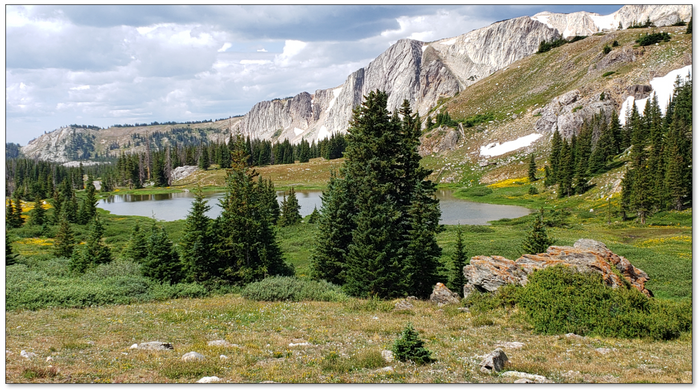

I was sure that at least I wouldn't starve to death on that vast and prosperous continent of North America!
I imagined that maybe @roleerob and @valued-customer would be offended by a lazy, rebellious person like me living in America!😉
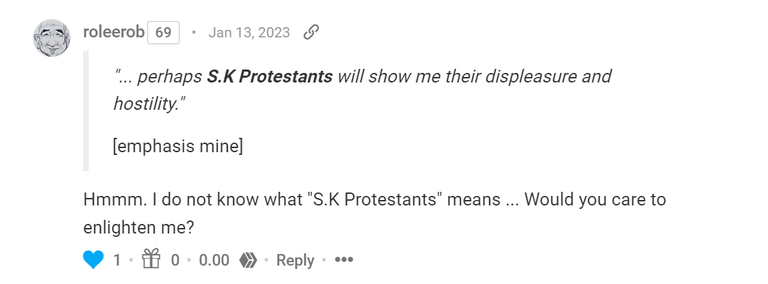
I thought about it for a long time after seeing @roleerob's comment.
I didn't know how to respond to his glorious request!
At present, I felt incapable of fully complying with his request.
However, I decided to write an article about the time and history of the spread of the first European Christianity to East Asia.
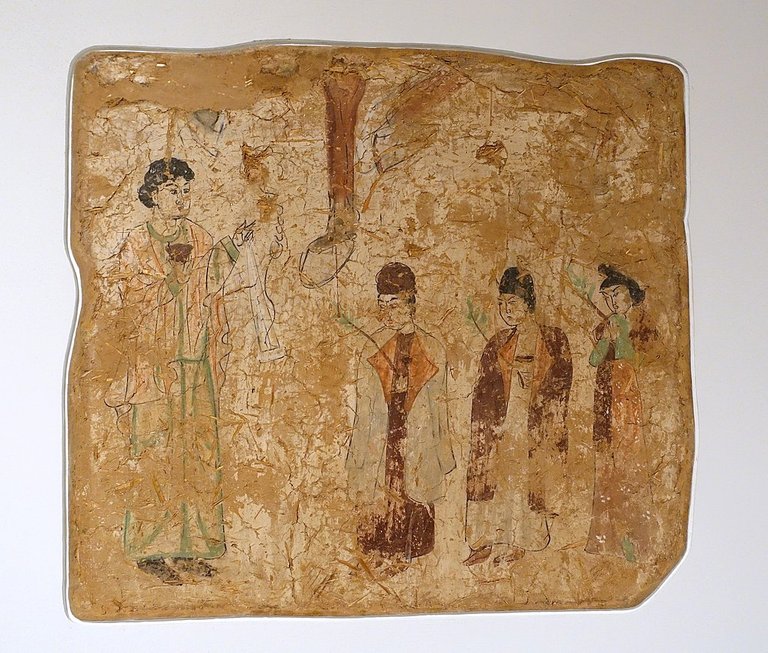 Nestorian priests in a procession on Palm Sunday, in a seventh- or eighth-century wall painting from a Nestorian church in Qocho, China
Nestorian priests in a procession on Palm Sunday, in a seventh- or eighth-century wall painting from a Nestorian church in Qocho, China
Nestorianism is a term used in Christian theology and Church history to refer to several mutually related but doctrinarily distinct sets of teachings.[1] The first meaning of the term is related to the original teachings of Christian theologian Nestorius (d. c. 450 AD), who promoted specific doctrines in the fields of Christology and Mariology. The second meaning of the term is much wider, and relates to a set of later theological teachings, that were traditionally labeled as Nestorian, but differ from the teachings of Nestorius in origin, scope and terminology.[2] The Oxford English Dictionary defines Nestorianism as "The doctrine of Nestorius, patriarch of Constantinople (appointed in 428), by which Christ is asserted to have had distinct human and divine persons."[3]
Original Nestorianism is attested primarily by works of Nestorius, and also by other theological and historical sources that are related to his teachings in the fields of Mariology and Christology. His theology was influenced by teachings of Theodore of Mopsuestia (d. 428), the most prominent theologian of the Antiochian School. Nestorian Mariology rejects the title Theotokos ('God-bearer') for Mary, thus emphasizing distinction between divine and human aspects of the Incarnation. Nestorian Christology promotes the concept of a prosopic union of two natures (divine and human) in Jesus Christ,[4] thus trying to avoid and replace the concept of a hypostatic union. This Christological position is defined as radical dyophysitism,[5] and differs from orthodox dyophysitism, that was reaffirmed at the Council of Chalcedon (451).[6] Such teachings brought Nestorius into conflict with other prominent church leaders, most notably Cyril of Alexandria, who issued 12 anathemas against him (430). Nestorius and his teachings were eventually condemned as heretical at the Council of Ephesus in 431, and again at the Council of Chalcedon in 451. His teachings were considered as heretical not only in Chalcedonian Christianity, but even more in Oriental Orthodoxy.[6]
After the condemnation, some supporters of Nestorius, who were followers of the Antiochian School and the School of Edessa, relocated to the Sasanian Empire, where they were affiliated with the local Christian community, known as the Church of the East. During the period from 484 to 612, gradual development led to the creation of specific doctrinal views within the Church of the East.[7] Evolution of those views was finalized by prominent East Syriac theologian Babai the Great (d. 628) who was using the specific Syriac term qnoma (ܩܢܘܡܐ) as a designation for dual (divine and human) substances within one prosopon (person or hypostasis) of Christ. Such views were officially adopted by the Church of the East at a council held in 612.[8] Opponents of such views labeled them as "Nestorian" thus creating the practice of misnaming the Church of the East as Nestorian.[9] For a long time, such labeling seemed appropriate, since Nestorius is officially venerated as a saint in the Church of the East.[10] In modern religious studies, this label has been criticized as improper and misleading.[11] As a consequence, the use of Nestorian label in scholarly literature, and also in the field of inter-denominational relations, is gradually being reduced to its primary meaning, focused on the original teachings of Nestorius
Nestorianism, persecuted as a heresy in the European Christian world, spread throughout the Asian world and finally reached China.
Nestorian missionaries were firmly established in China during the early part of the Tang dynasty (618–907); the Chinese source known as the Nestorian Stele records a mission under a Persian proselyte named Alopen as introducing Nestorian Christianity to China in 635. The Jingjiao Documents (also described by The Japanese scholar P. Y. Saeki as "Nestorian Documents") or Jesus Sutras are said to be connected with Alopen.[30]
Nestorianism reached China around the 7th century and made great progress.
Nestorianism had the name of 景敎 ( chinese pronounce: Jing jiao) in China.
Nestorianism missionaries did missionary work while serving the Chinese with the excellent medical skills of Europe and Islam.
After receiving their treatment, the Chinese emperor built a temple for them.
Alopen (Chinese: 阿羅本, fl. AD 635; also "Aleben", "Aluoben", "Olopen," "Olopan," or "Olopuen")
Alopen (Chinese: 阿羅本, fl. AD 635; also "Aleben", "Aluoben", "Olopen," "Olopan," or "Olopuen") is the first recorded Assyrian Christian missionary to have reached China, during the Tang dynasty. He was a missionary from the Church of the East (also known as the "Nestorian Church"),[1] and probably a Syriac speaker from the Sasanian Empire or from Byzantine Syria.[citation needed] He is known exclusively from the Xi'an Stele, which describes his arrival in the Tang capital of Chang'an in 635 and his acceptance by Emperor Taizong of Tang. His is the earliest known name that can be attached to the history of the Church of the East in China.
The Jingjiao Documents (Chinese: 景教經典; pinyin: Jǐngjiào jīngdiǎn; also known as the Nestorian Documents or the Jesus Sutras) are a collection of Chinese language texts connected with the 7th-century mission of Alopen, a Church of the East bishop from Sassanian Mesopotamia, and the 8th-century monk Adam. The manuscripts date from between 635, the year of Alopen's arrival in China, and around 1000, when the cave at Mogao near Dunhuang in which the documents were discovered was sealed.
By 2011, four of the manuscripts were known to be in a private collection in Japan, while one was in Paris. Their language and content reflect varying levels of interaction with Chinese culture, including use of Buddhist and Taoist terminology.[1]
However, Nestorianism in China began to be persecuted around the 9th century and disappeared around the 13th century after being absorbed by Islam and Buddhism.
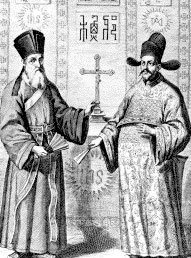 Matteo Ricci with Xu Guangqi (right)
Matteo Ricci with Xu Guangqi (right)
Matteo Ricci, SJ (Italian pronunciation: [matˈtɛːo ˈrittʃi]; Latin: Mattheus Riccius; 6 October 1552 – 11 May 1610), was an Italian Jesuit priest and one of the founding figures of the Jesuit China missions. He created the Kunyu Wanguo Quantu, a 1602 map of the world written in Chinese characters. On the 17 December 2022 the Apostolic See declared its recognition of Ricci’s ‘heroic virtues’, thereby bestowing upon him the honorific of Venerable.[1]
Ricci arrived at the Portuguese settlement of Macau in 1582 where he began his missionary work in China. He became the first European to enter the Forbidden City of Beijing in 1601 when invited by the Wanli Emperor, who sought his services in matters such as court astronomy and calendrical science. He converted several prominent Chinese officials to Catholicism. He also worked with several Chinese elites, such as Xu Guangqi, in translating Euclid's Elements into Chinese as well as the Confucian classics into Latin for the first time in history.
With the arrival of the 16th-century Italian missionary Matteo Ricci, SJ (Italian pronunciation: [matˈtɛːo ˈrittʃi]; Latin: Mattheus Riccius; 6 October 1552 – 11 May 1610) in China, Roman Catholicism gained great influence in the East Asian world.
Scholars in modern China, Japan and Korea called him a genius.
He taught Chinese scholars about European science, mathematics, philosophy, and theology because he had a great talent for Chinese language and Chinese characters.
The Chinese, who read European scientific, philosophical, and theological books he had translated into Chinese, were attracted to the superior Roman Catholic culture.
So, many Chinese converted to Catholicism.
European science, mathematics, and theology books he translated were imported to Korea and Japan, which greatly helped spread the Roman Catholic faith.
This is because many Koreans and Japanese were impressed by Roman Catholic's outstanding science, mathematics, and theological thought.
My friends Steve and Joseph, who are ardent Protestants, will be surprised by my interest in Catholic history and theology!
Since Roman Catholicism settled in the East Asian world 400 years before Protestantism, many non-Christian East Asians recognize the Roman Catholic pope as the vicar of God!
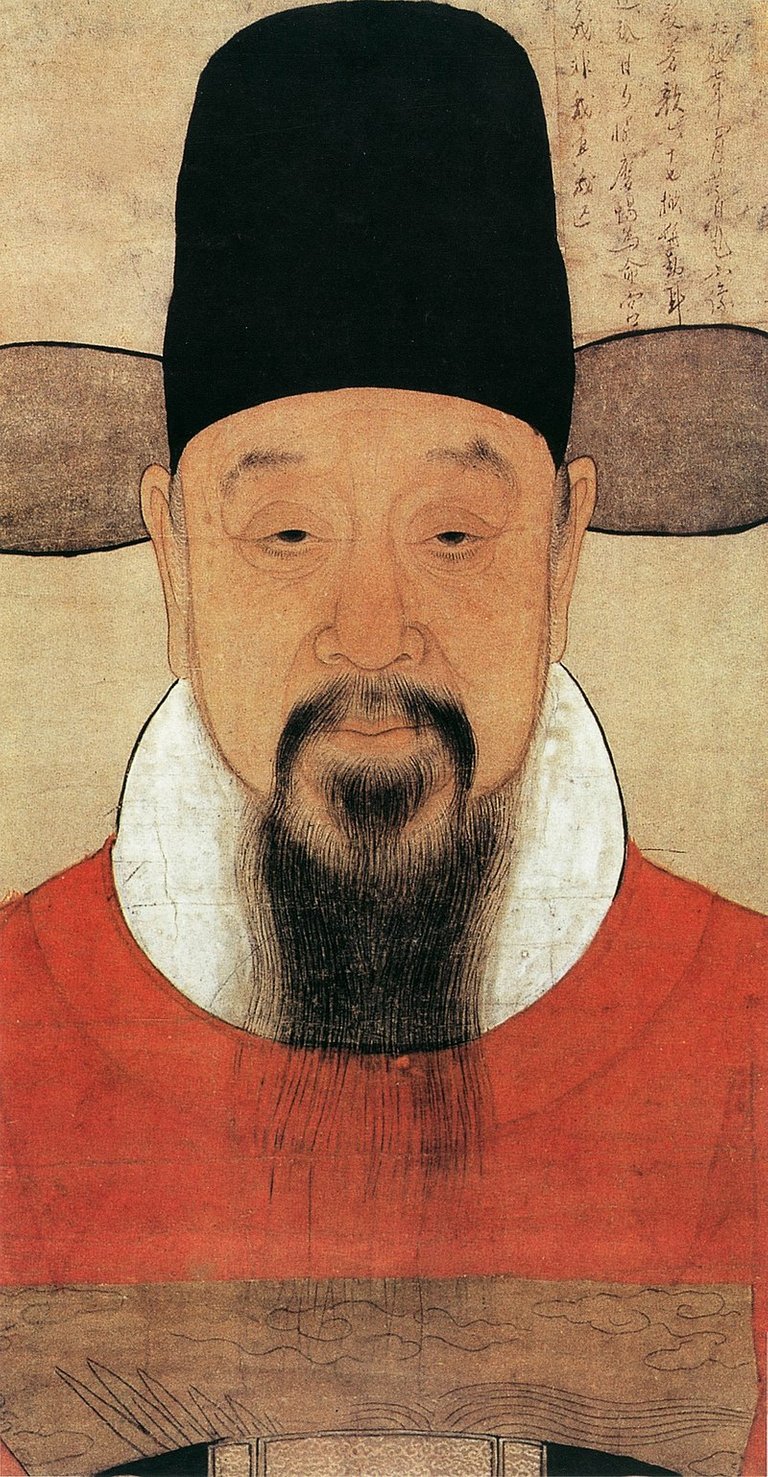 Xu Guangqi
徐光啓
Xu Guangqi
徐光啓
Xu Guangqi or Hsü Kuang-ch'i (April 24, 1562 – November 8, 1633), also known by his baptismal name Paul, was a Chinese agronomist, astronomer, mathematician, politician, and writer during the Ming dynasty.[6] Xu was appointed by the Chinese Emperor in 1629 to be the leader of the ShiXian calendar reform, which he embarked on with the assistance of Jesuits.[7] Xu was a colleague and collaborator of the Italian Jesuits Matteo Ricci and Sabatino de Ursis and assisted their translation of several classic Western texts into Chinese, including part of Euclid's Elements. He was also the author of the Nong Zheng Quan Shu, a treatise on agriculture. He was one of the "Three Pillars of Chinese Catholicism"; the Roman Catholic Church considers him a Servant of God.[8] On April 15, 2011, Vatican spokesman Federico Lombardi announced the beatification of Xu Guangqi.[9][10]
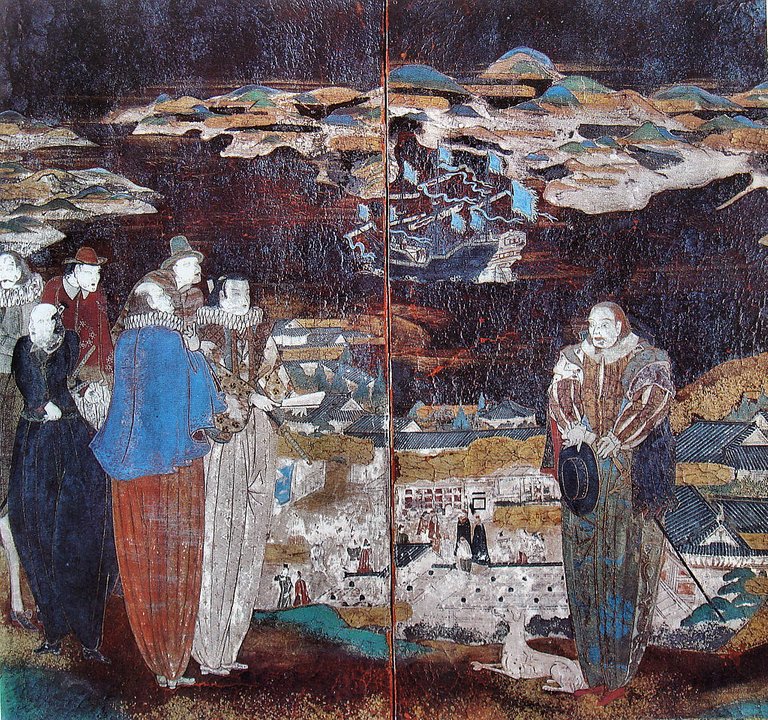 Japanese Christians in Portuguese costume, 16th–17th century.
Japanese Christians in Portuguese costume, 16th–17th century.
The Japanese term Kirishitan (吉利支丹, 切支丹, キリシタン, きりしたん), from Portuguese cristão (cf. Kristang), meaning "Christian", referred to Catholic Christians in Japanese and is used in Japanese texts as a historiographic term for Catholics in Japan in the 16th and 17th centuries.
Modern Japanese has several words for "Christian", of which the most common are the noun form kirisuto-kyōto キリスト教徒, and also kurisuchan クリスチャン. The Japanese word kirishitan キリシタン is used primarily in Japanese texts for the early history of Roman Catholicism in Japan, or in relation to Kakure Kirishitan, hidden Christians. However, English sources on histories of Japan generally use the term "Christian" without distinction.
Christian missionaries were known as bateren (from the Portuguese word padre, "father" or "priest")[1] or iruman (from the Portuguese irmão, "brother"). Both the transcriptions 切支丹 and 鬼利死丹 came into use during the Edo Period when Christianity was a forbidden religion.
Portuguese ships began arriving in Japan in 1543,[2] with Catholic missionary activities in Japan beginning in earnest around 1549, mainly by Portuguese-sponsored Jesuits until Spanish-sponsored mendicant orders, such as the Franciscans and Dominicans, gained access to Japan. Of the 95 Jesuits who worked in Japan up to 1600, 57 were Portuguese, 20 were Spaniards and 18 Italian.[3] Francis Xavier,[4][5] Cosme de Torres (a Jesuit priest), and João Fernandes were the first to arrive to Kagoshima with hopes to bring Christianity and Catholicism to Japan. At its height, Japan is estimated to have had around 300,000 Christians.[6] Catholicism was subsequently repressed in several parts of the country and ceased to exist publicly in the 17th century.
Yi Seung-Hun (1756 – April 8, 1801, Ja: Jasul (子述), Ho: Mancheon, baptismal name Peter)
Roman Catholicism was spread in East Asia 400 years earlier than Protestantism and is respected by many East Asians because it produced numerous martyrs.
I am very interested in Scholasticism .
I felt that scholasticism had many similarities with East Asian religions and philosophies.
By the way, Perhaps Steve and @valued-customer seem to be against the Roman Catholic ideology!
PS: I called him Steve because my bro Joseph called him Steve.
I want to ask him if I've done anything rude.
Some called him Steven.
I hope he understands that I am not familiar with American customs!😅



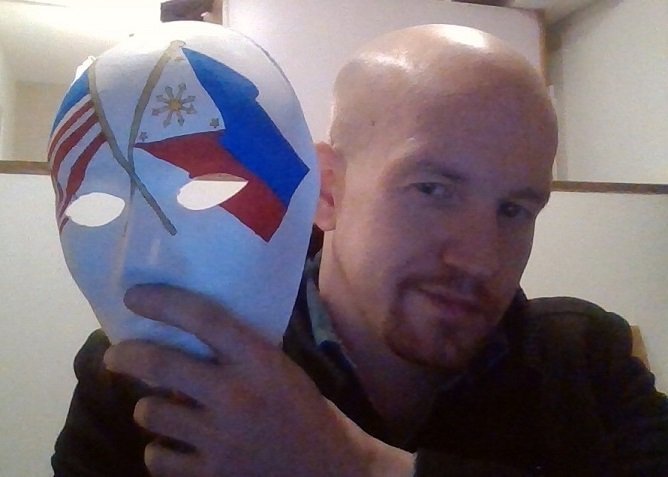



Yes, you most likely do. 😜 I'd be surprised if you didn't, for the same reason that I probably know Western history better than you: people tend to know our places of origin better than we know foreign lands.
"Tabloid writer" though? Ouch!🤣🤣🤣
Perhaps tabloid is more synonymous with periodical in translation. I would certainly agree you have a more than professional competence suitable to serialization in print.
Well thank you for such high praise, @valued-customer, and it's good to hear from you again. I think he was referring to how sensationalized and admittedly partial a lot of my articles are.
Well, I can see your point.
My reason agrees with @valued-customer , but my feelings agree with @patriamreminisci !
In fact, I have a stronger feelings side!
I believe that geniuses don't always make the right decisions!😆
(Second comment)
It took a long time to get through this, but it's definitely a new perspective. As to @roleerob's comment that you alluded to in the article, I believe "S. K. Protestants" means "South Korean Protestants." In other words, he was challenging you to come back with a rebuttal. 😉
As usual, I find some things in the article that seem a little bit strange but it may well be you who is right rather than me.
🌄Good morning (here)!☕
I always enjoy reading your writing efforts, my East Asian friend! 😉 They always reinforce my overall impression of the value being "in here." Which presents me with the opportunity to read directly the thoughts of people from all over the world. Directly. Without any censorship or anything between me and them ...
I also am blessed by experiencing the interaction with others. @valued-customer and @patriamreminisci are two of my favorites. They communicate well and are not afraid of letting their views be known. While we may not agree on everything, the world would be a boring place, if we did. It is one of the great "pillars" of American history that we are free to express ourselves, although a "war" is underway to bring that to an end ...
Your subject is interesting. I read every word of your post. Are you writing a series? Which will end with a clear definition / explanation of what being an "S.K. Protestant" represents to you? I was / am interested to know the answer, in particular what you were seemingly fearful of, if your writings came to their attention.
Not to detract from your post, but "bowing" to the limitations of this form of human interaction ... I would encourage our friends to get a CT Calcium Scan. THE definitive initial test on how good your cardiovascular health is. Don't have insurance to pay for it? Find the money and do it anyway. Do NOT think of it as "I can't afford it" ... Think of it as "I can't afford NOT to pay for it" It is that important. A baseline NUMBER against which you can compare how you are doing in the future against whatever this number tells you now. In particular, I hope @valued-customer will consider this, if he has not already done so ...
I am now home from having survived my very recent discovery of the implications of this number on my own life. And mortality ... I am very fit for my age. Had ZERO of the "co morbidities" that most struggle with in our time. At least in most of our western cultures (SAD => Standard American Diet => Really most of the western world, not just America ...).
Doesn't matter. I barely survived it.
Your survival is consolation I have not suspected needful given your good life. I am happy to know you are fortified by your understanding, better able to continue to enjoy the fruits of your hard work.
You, I am sure, would be surprised to know how deeply your concern has affected me. When I have run my prey to ground I will savor the stag providence grants me. I am certain sure that the feast to follow will sate the horde that partakes.
Until then I will always remember your kindness.
When I read your post I feel I know nothing of the topic!
I am totally unknown of the terms like Catholicism, Protestantism, Scholasticism and so on!
"as-salaam 'alaykum" @tanzil2024 !
I had studied the Bible and Christian history and theology in the past.
Scholars in East Asia, including China, learned European philosophy, science, mathematics, and theology through Roman Catholicism.
Me, too.
For my part I am unsurprised you find Catholicism amenable, as my experience finds Presbyterianism quite similar in practice, if differing theologically.
Quite the contrary. I myself am extremely lazy, almost fanatical about doing things right the first time so I don't have to do them over. In my career as a carpenter I have found there are two schools of thought. My own, which advocates we 'Don't just do something, sit there!' (taking time to think carefully before irreversibly acting), and that which I abhor, 'Do something, even if it's wrong!'. I find the latter course too often results in doing things wrong, which costs money in materials and labor to do. Thereafter, in order to complete the project, whatever has been done wrong needs to be undone, costing more labor and wasting material. Then, at last, it can be done right, requiring yet more expenditures in material and labor. Since I am lazy, and cheap, I much prefer to only do things, and pay for them, once.
In terms of politics, rebellious is my foremost and favorite trait. Since I also abhor being burned at the stake as a heretic, I do in fact disagree with Catholic ideology, which certainly would class my views as heresy.
Thanks!
Dear @valued-customer!
Whenever I see your brilliant and wonderful sentences, I always worry about what great answers I should give!😂
You always overload the brain of an American elementary school student like me.🤣
I will give my answer next time.
Thank you!